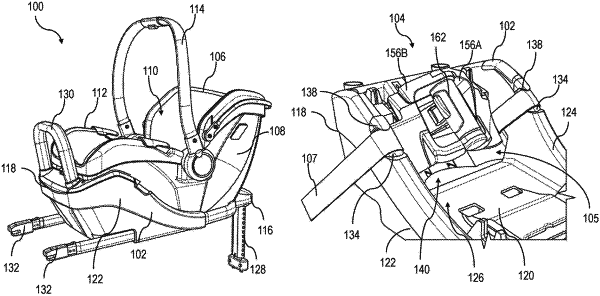| CPC B60N 2/2806 (2013.01) [B60N 2/2821 (2013.01); B60N 2/2845 (2013.01); B60N 2002/2815 (2013.01)] | 4 Claims |

|
1. A child seat configured to be secured to a car seat, the child seat comprising:
a base comprising a receiving region, wherein the base is configured to receive a belt of the car seat at least within the receiving region and to secure the child seat to the car seat; and
a tensioning mechanism pivotably attached to the base within the receiving region, wherein the tensioning mechanism comprises first and second top arms and first and second bottom arms, wherein the first top arm is pivotably attached to the first bottom arm, wherein the second top arm is pivotably attached to the second bottom arm and pivotably attached to the first top arm, wherein the first and second bottom arms are pivotably attached to the base, wherein the tensioning mechanism is adjustable between a first configuration and a second configuration, wherein, in the first configuration, the first top arm is at a first angle relative to the first bottom arm and the tensioning mechanism is configured to receive a portion of the belt, wherein, in the second configuration, the first top arm is at a second angle relative to the first bottom arm that is different from the first angle and the tensioning mechanism is configured to apply tension to the portion of the belt, wherein the second angle is less than the first angle, wherein, in the first configuration, the first top arm extends at a non-straight angle relative to the second top arm and in the second configuration the first top arm extends parallel to the second too arm, and wherein in the second configuration an end of the first bottom arm opposite the end where the first bottom arm pivotably attaches to the first top arm meets an end of the second bottom arm opposite the end where the second bottom arm pivotably attaches to the second top arm.
|